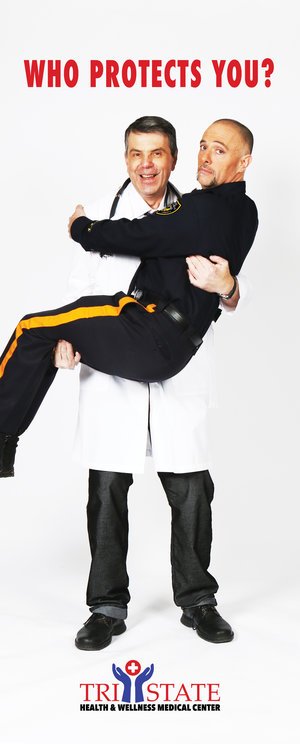The Impact of the Sympathetic Nervous System on First Responders
/By: Joel E. Gordon
The sympathetic nervous system (SNS) is a branch of the autonomic nervous system that controls involuntary bodily functions in response to stress or perceived danger. It prepares the body for the "fight or flight" response.
I can remember that as a newer driver, before my days of public service, the feeling I experienced upon a sudden obstacle in my vehicle’s path, such as a suddenly darting animal in front of me, would result in a rushed feeling of panic (a brief involuntary instant jumpy feeling along with stomach unrest followed by a weakened letdown, is the best description I can muster).
After many emergency responses and potentially violent encounters, I found that I no longer experienced the aforementioned feeling. This was as a result of burnout from too many adrenaline rushes initiating the sympathetic nervous response over a period of time. I am certain many of you know what I am referring to and although my SNS response has somewhat returned in “retirement” it will never be completely restored.
High stress levels among first responders remain a pressing concern. Studies show that these brave professionals experience chronic stress far more than the general population. This stress response largely involves the sympathetic nervous system (SNS), a critical part of how our bodies react to danger and pressure.
Image Source: https://pixabay.com/photos/depression-anxiety-stress-depressed-3912748/
When the SNS activates, the body prepares for a fight-or-flight response. Heart rate increases, blood pressure rises, and breathing becomes rapid. This physiological reaction is essential in life-threatening situations, allowing first responders to act quickly. However, these states of heightened alertness can become problematic.
Statistics reveal that 30% of first responders experience chronic stress-related health issues, including heart disease and diabetes. Research indicates that first responders are more likely to suffer from stress-related illnesses than their peers.
Acute stress occurs in response to immediate threats, such as responding to an emergency. For instance, a firefighter rushing into a burning building experiences acute stress, spurring quick action. However, chronic stress builds over time, resulting from the constant pressure of the job.
For example, dealing with traumatic incidents repeatedly can overwhelm a first responder's ability to cope. Prolonged SNS activation can lead to severe health problems, such as anxiety and heart issues.
Adrenaline and cortisol are crucial in the body's response to stress. Adrenaline boosts energy while cortisol helps manage stress levels over time. However, prolonged exposure to these hormones can lead to hormonal imbalances, increasing the risk of obesity, diabetes, and cardiovascular problems. Research shows that first responders often have elevated cortisol levels, which can have serious long-term health effects.
Prolonged activation of the SNS is strongly linked to post-traumatic stress disorder (PTSD). Research indicates that 20% to 30% of first responders develop PTSD, often a result of exposure to traumatic events. Experts emphasize the need for greater awareness of how chronic stress affects mental health.
Anxiety and depression are common among first responders. Chronic stress can create a challenging environment where these conditions thrive. For example, a firefighter may experience heightened anxiety after a traumatic call, affecting their personal life and work.
Studies show that nearly 40% of first responders report symptoms of anxiety and depression, highlighting the importance of mental health awareness in this field.
Burnout and compassion fatigue also are significant challenges linked to the SNS. These conditions arise from ongoing stress and emotional exhaustion. Symptoms may include irritability, reduced performance, and detachment from work.
Recognizing these symptoms early can help prevent further decline. Experts suggest coping strategies like setting boundaries and ensuring time for self-care to manage these issues effectively.
Chronic SNS activation is strongly correlated with increased risks of heart disease among first responders. Studies show that first responders are nearly twice as likely to develop heart issues compared to the general population. The stress hormone cortisol can lead to inflammation and other cardiovascular problems.
Stress can also wreak havoc on the digestive system. First responders may face issues like ulcers and irritable bowel syndrome. The link between stress and gastrointestinal problems is well-documented, with research indicating that high-stress jobs increase the likelihood of such health concerns.
Chronic stress can weaken the immune system. This suppression can lead to increased illness rates among first responders. Research shows that they are more susceptible to infections, further complicating their health and recovery.
Mindfulness and meditation can help regulate the SNS response. These practices encourage relaxation and stress reduction. Simple techniques, like focused breathing or guided meditation, can be practiced daily.
Research supports the effectiveness of mindfulness, showing reductions in stress and anxiety levels among participants.
Regular physical activity is vital for managing stress. Exercise releases endorphins, which help boost mood and alleviate stress. First responders can benefit from activities like running, hiking, or team sports. Even a regular walk can significantly reduce stress.
Studies show that those who exercise regularly report lower stress levels and better overall health.
Support networks play a crucial role in mitigating stress. Connecting with colleagues or joining peer support groups can create a sense of belonging and share experiences. Seeking professional help is equally important for those experiencing difficulty managing stress.
Professional therapy offers valuable support for managing stress and PTSD. Techniques like cognitive-behavioral therapy can be particularly beneficial for first responders. Resources are available across the country, providing a pathway to recovery.
Some organizations offer Employee Assistance Programs, which provide confidential support for first responders. These programs can give access to counseling, stress management services, and wellness programs. Utilizing EAPs is a proactive step towards better mental health.
Mental health apps can be accessible tools for support. Options like Headspace or Calm provide guided meditation and mindfulness resources. However, while technology can aid in mental health management, it’s essential to balance its use with personal interactions and professional help.
The impact of the sympathetic nervous system on first responders is profound and multifaceted. Addressing the challenges posed by stress is vital for ensuring their physical and mental well-being. Recognizing symptoms, seeking support, and employing effective coping strategies can significantly enhance health. Prioritizing mental and physical health is not just a personal choice; it’s an essential step towards a healthier community.
Joel E. Gordon, Managing Editor of BLUE Magazine, is a former Field Training Officer with the Baltimore City Police Department and is a past Chief of Police for the city of Kingwood, West Virginia. He has also served as vice-chair of a multi-jurisdictional regional narcotics task force. An award winning journalist, he is author of the book Still Seeking Justice: One Officer's Story and founded the Facebook group Police Authors Seeking Justice. Look him up at stillseekingjustice.com









